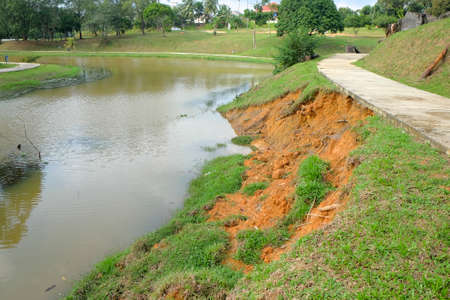The rainy season can bring changes to our shorelines and waterways. Drainage systems are tested for the first time after the dry season. Soils that were once scorched become saturated. If you live on or near the water, you learn to keep a close eye out for any disturbances after a strong rain event.
Yes, heavy rain can cause a washout along a lake embankment. A washout refers to the erosion and removal of soil or sediment from an embankment due to the force of flowing water. When heavy rainfall occurs, the runoff from the surrounding area can accumulate and flow along the embankment, exerting a significant amount of hydraulic force. This force can cause the soil to erode and be washed away, leading to the formation of channels, gullies, or depressions along the embankment.
Several factors contribute to the susceptibility of an embankment to washouts during rainfall events:
- Slope Gradient: Steeper embankment slopes are more vulnerable to washouts as the flowing water has a greater velocity and erosive force. Gentle slopes are less prone to significant erosion. Today, many planned communities or water features have design criteria with this in mind, opting for a gradual sloping such as a 4:1 or 3:1.
- Soil Type: The type and composition of the soil on the embankment play a crucial role. Soils with poor drainage, low cohesion, or high sand content are more susceptible to erosion and washouts, such as the ‘sugar sand’ found in Florida. Clay soils may also be prone to erosion if they become saturated and lose their strength. These clay soils will show signs of broken ‘chunks’ as, over time, they break off and crumble into the lake. Here’s a friendly reminder that Landshore’s in-house engineering team has the expertise to test soil samples and determine key factors such as the type of soil, permeability, bearing capacity, and more.
- Vegetation Cover: The presence of vegetation, such as grasses, shrubs, or trees, can provide stabilization and help reduce erosion. Vegetation reduces surface flow velocity and enhances soil cohesion, mitigating the risk of washouts. However, it’s important to note that repairing the washout area with fill and vegetation alone may not correct the issue. If the area continues to receive high flows, further washouts and increased sedimentation of the lake or pond will occur. Sometimes an added layer of erosion control is necessary to reinforce the soils while facilitating proper drainage.
- Stormwater Management: The effectiveness of stormwater management systems, such as drainage channels, swales, or culverts, in diverting or managing runoff can impact the potential for washouts. Inadequate or poorly maintained drainage infrastructure may result in concentrated flows along the embankment, increasing the risk of erosion. Regular maintenance of these systems is recommended to keep their designed effectiveness in handling excess rainfall.
To prevent or minimize washouts along lake embankments, various erosion control measures can be implemented, such as:
– Installing erosion control blankets or concrete block mats to stabilize the soil surface.
– Constructing terraces or berms along the embankment to reduce the slope gradient and slow down the flow of water.
– Implementing erosion control structures to protect vulnerable areas, such as Eco-Filter Tubes, rock riprap, gabions, or retaining walls, like the Prolock Sigma Sheet Piling system recently featured on our ‘Projects’ page.
It is important to assess the specific conditions of the embankment and consider erosion control measures that are appropriate for the site. Local regulations, expert advice, and best management practices should be followed to prevent or mitigate the risk of washouts and maintain the stability of embankments.
Important dates: Florida’s rainy season typically falls between May and October (National Weather Service). In other states, like South Carolina, rainfall historically peaks in the summer months.
If you have a question regarding your waterfront, contact Landshore now to have an expert review the challenge and to help find an optimum solution. To read more from Landshore’s engineering team, be sure to follow us on our social media channels below.

